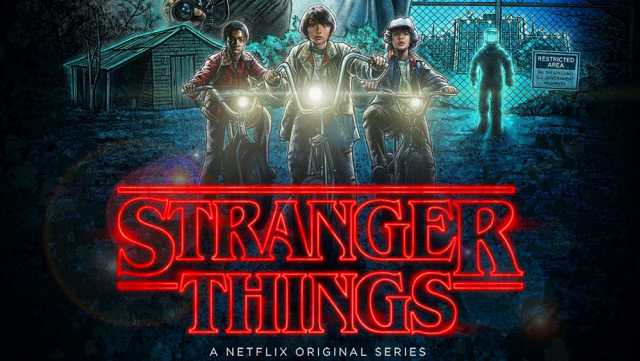Welcome to Guidance, Private Sanctuary’s source for tips and techniques for the Pathfinder Roleplaying Game, written by Everyman Gamer Alexander Augunas. Today, we’re going to be talking about Season 1 of Stranger Things.
Its been nearly two years since I did a new Algalon Paradigm article—so long that some of you might not have ever read one before! Algalon Paradigms are named after the World of Warcraft character, Algalon, who comes to judge the world of Azeroth to determine if it is worth saving, or if it should be utterly destroyed. And while I don’t have the power to destroy things that I don’t like, I certainly do have the power to tell you if I think they’re worth watching. Of course, these articles are all themed around Pathfinder, so the purpose will be to discuss what sort of lessons you can learn from each “world” to improve your GMing or playing.
With this in mind, let’s talk about the series that inspired me to pull this article type out of retirement—the critically acclaimed Stranger Things.

Stranger Experience
So, what makes Stranger Things, well, strange? This Netflix original series is basically a period piece—the minute the episodes start rolling, you can tell that the directors did EVERYTHING they could to make Stranger Things ooze the eighties. I mean, I wasn’t even ALIVE in the 80s and I could tell the look and feel they were going for. Not only to the characters look and talk like people in the 80s did, but the set pieces are all chronologically appropriate and even the title cards, transitions, film techniques, and lettering is reminiscent of the 80s. If you are an 80s kid, you’re in for some grade-A nostalgia.
So, what’s the hook for this series that makes it so good? Well, its basically a cosmic mystery / horror story with a fair bit of occultism thrown in too. And ALL of it, freaking ALL of it is explained to the viewer using Dungeons and Dragons terminology. No, seriously. I kid you not. EVERYTHING is relayed in Dungeons and Dragons lingo because four of the main characters are 13-year old boys who play Advanced D&D in the basement of the GM’s mother. Its just as great as it sounds. You can see why I absolutely HAD to bring this blog type out of retirement now, right?

Stranger Lessons
Warning! This section will have minor spoilers. Turn back now if you don’t want minor spoilers!
So, aside to pandering to the childhood of every D&D nerd in existence, what does this show have that makes it so worthwhile to GMs and players? Allow me to tell you:
- Shadow Plane: Stranger Things has the absolute best visual (yes, VISUAL) depiction of the Shadow Plane that I have ever seen. Note that “Shadow Plane” is Pathfinder lingo—they call it something else in the series, and if you’re an AD&D fan you probably know what that “something” is. No spoilers.

S1 Ep5 — A Visual Aid used to explain Parallel Universe Theory in Stranger Things.
- Plane Shifting: Stranger Things not only has the best visuals for planar travel that I have ever seen, but it also has the absolute BEST explanation for how planar travel functions, both in a real-world-sense (see Many Worlds Theories and Quantium Physics) but also in the context of Pathfinder itself. Seriously, the explanation given in The Flea and the Acrobat is the answer we should be giving to our players EVERY time they ask us how extraplanar travel functions. EVERY. SINGLE TIME.
- Multi-Generational Heroes: For me, this was the absolute best aspect of the series—you have main characters doing important things who are from a range of generations. The show is basically split into several “factions” who it follows, and over time they slowly coalesce into a single group. First you have “The Nerds,” which are comprised of a group of 12-13 year old kids. Next, there’s “The Beyers,” which are comprised of a 16-17 year old teen and his mother (35–45). Then, there’s “The Cool Kids,” which are comprised of a group of five-ish 16–17 year old kids. Finally, there’s “The Law,” which consists of the town sheriff (35–45). All of these characters are competent. All of them capable, and all of them interesting in their own way. You aren’t going to like all of them, true, but they take mostly intelligent actions and when they make mistakes, you can understand why they happen. The kids and teens, for instance, don’t necessarily blunder because they’re young and inexperienced—the stakes are high for these characters, and one character trait that quickly becomes apparent is that they’re all loyal people. All of them have lost something or someone, and they’re all willing to take risks to try and get their loved ones back. Or at least get closure….
- Lovecraftian Horror: I’ve heard people call Stranger Things a “Love Song to Spielberg,” and that isn’t untrue—Spielberg drew a lot of influence for some of his creepier movie moments from H.P. Lovecraft, and those influences SHINE in Stranger Things. The Duffer Brothers are a master of horror techniques. Absolute masters. And one thing that is clear from early on is that they’re not afraid to use darkness to scare you. Oftentimes movie and television producers will shy away from darkness because it, “obscures the set.” No! That’s what you WANT! Darkness and the unknown are SCARY, and this series proves why.
 Ordinary into Horrific: Similar to the Paranormal Activity franchise, this series is AWESOME at taking ordinary things and making them horrifying. No more info than this, but Christmas lights, man. The series made CHRISTMAS LIGHTS scary! This is a very effective technique for a GM to master.
Ordinary into Horrific: Similar to the Paranormal Activity franchise, this series is AWESOME at taking ordinary things and making them horrifying. No more info than this, but Christmas lights, man. The series made CHRISTMAS LIGHTS scary! This is a very effective technique for a GM to master.- Foreshadowing: There is a LOT of foreshadowing in this series. Like, a LOT of it. Too much for me to describe. (For instance, when Winnoa Ryder’s character finds the Christmas Lights in episode 2, and how they end up getting used in later episodes.)
- Always End with a Scare: If this series does one thing well, it ALWAYS ends with a scary cliffhanger, then resolves that cliffhanger early in the next episode. That way, you are drawn into the next episode and are ready to see how the plot develops. Its like Lost’s strategy, but done effectively. Questions are answered all the time, and they’re clearing pointing TO something, but new questions arise just as often, though never so many that they’re overwhelming.
- The Law is Competent: Holy crap, THE SHERIFF DOES HIS JOB AND INVESTIGATES THINGS EVEN THOUGH THEY SOUND CRAZY! OMG! You have no idea how refreshing this is. Law enforcement should NEVER be incompetent unless its important to the story you are telling.
- Men in Black: The series has an AWESOMELY creepy governmental agency loaming in the background, and that’s something I wish that fantasy RPGs made more use of. (Dario and I did in our upcoming 3PP release, Pact Magic Unbound: The Grimoire of Lost Souls.) Basically, you never want the horror to come from a single thing, but you want those things to be connected. Stranger Things is MASTERFUL at this, as it establishes the connection early on.
- Don’t Be Afraid to Keep Secrets: The series never shows you what its Lovecraftian Horror looks like. Its almost always in the shadows, and your best look at it doesn’t happen until the final episode. Sure, the CHARACTERS have seen it, and they’ve seen more than you have. Its sort of the opposite of the “omnipresent audience,” a story technique where the audience sees things that the characters can’t. The fact that the characters have seen something off-camera that you haven’t is REALLY scary, especially in regards to how they react to the things they’ve seen. I think a technique of having your PCs “see” something that their players haven’t could also be REALLY scary.
Well, that about covers my thoughts on Stranger Things. I hope I’ve inspired at least a few of you to give Stranger Things a go, and if you’ve seen it, I hope I’ve giving you some ideas of where you can grab neat ideas from your campaign. Here’s hoping Season 2 is just as awesome as Season 1! (And that we get more 11.)
Alexander “Alex” Augunas has been playing roleplaying games since 2007, which isn’t nearly as long as 90% of his colleagues. Alexander is an active freelancer for the Pathfinder Roleplaying Game and is best known as the author of the Pact Magic Unbound series by Radiance House. Alex is the owner of Everyman Gaming, LLC and is often stylized as the Everyman Gamer in honor of Guidance’s original home. Alex also cohosts the Private Sanctuary Podcast, along with fellow blogger Anthony Li, and you can follow their exploits on Facebook in the 3.5 Private Sanctuary Group, or on Alex’s Twitter, @AlJAug.







Yep, excellent show. My favorite thing to come out of the show, however, is how my GM, Jared (aka @WoolyToots) immediately tweeted out “Stranger Things is really cool, but those troglodyte miniatures are from 2006. And the Demigorgon is from 1984.” Dude is an OG gamer for real.